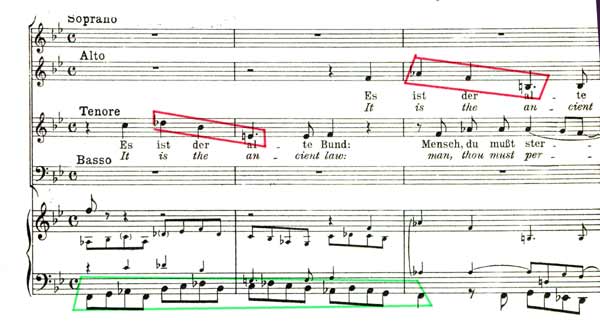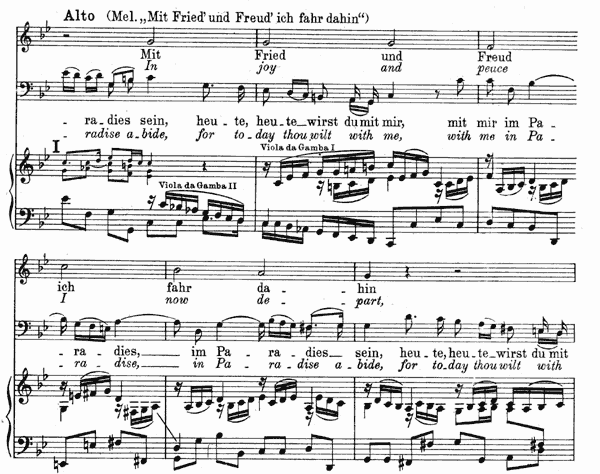Cantata 106 was an early work, likely written in 1707 or 1708, when Bach was in Mühlhausen. The earliest surviving manuscript, in the hand of an anonymous copyist, bears the marking “Leipzig,1768.” Often called the “Actus Tragicus,” the cantata was among the first published after Bach’s death, though, to the best of our knowledge, it was never performed in his lifetime. No one knows the circumstances for which the cantata was written; based on the text, most assume that it was written for a funeral, perhaps that of Bach’s uncle Tobias Lämmerhirt, who died in 1707. The fact that the text is so unified under the theme of death, both under the Law and the Gospel (Chafe), helps lend credence to the idea that this cantata was written for a funeral service. The use of text from both the Old and New Testaments references the idea of man’s mortality at the same time that it reminds us of God’s presence throughout history; at the same time, we are reminded of God’s role in man’s salvation, whether that be the salvation of the Israelites, the arrival of Christ on earth, or the salvation of all believers at the Last Judgment.
Early editions of Cantata 106 are written in E-flat, with later editions appearing in F. The transposition to F “eliminates several unplayable notes for the recorders”, and may have been the motivating factor for the key change; modern singers also appreciate the move to F, since there are several low E-flats in the bass line, and a low F in the altos. (On the other hand, a move up a whole step means repeating high F’s for the solo bass.) Most performances, however, use the E-flat setting.
Although movements are marked by tempo changes, occasionally key changes, meter changes, and double bar lines (not thick, bold bar lines, however, as at the end of a work), Cantata 106 appears to be a continuous work. Bach helps create a more seamless effect by occasionally resolving the cadence of one section at the downbeat of another, thus blurring the beginnings and endings of traditional movements.
The text comes from both the Bible and the chorales “Ich dich hab ich gehoffet, herr” (by Adam Resuner, 1533) and “Mit Fried und Freud ich fahr dahin” (Luther).
Let me summarize the sections (since these are not always self-contained I prefer to not call them “movements”) below, before discussing in more detail some of the more interesting moments. All vocal parts plus all orchestral parts together will be indicated as “tutti” below.
| Section | Tempo & Meter | Key | Text Source | Scoring | Texture |
| 1 (Sonatina) | Molto Adagio, 4/4 | E-flat | None | 2 flutes, 2 viols da gamba, continuo | Essentially duet between the flutes, with string/continuo accompaniment |
| 2 | Moderate, 4/4 | E-flat | Unknown | Tutti | Florid, homophonic |
| 3 | Allegro, 3/4 | B-flat to E-flat |
Act 17: 28 |
Tutti | Fugal to start, moving to chordal |
| 4 | Adagio assai, 4/4 | C minor | Acts 17 | Tutti | Florid, homophonic |
| 5 | Lento, 4/4 | C minor | Psalm 90:12 | Tenor, flutes, viols da gamba, continuo | Florid solo voice with ornate accompaniment (producing polyphonic texture) |
| 6 | Vivace, 3/8 | C minor to F minor | Isaiah 38:1 | Bass, flutes, viols da gamba, continuo | solo voice (less florid that the preceding movement) with ornate accompaniment (producing polyphonic texture) |
| 7 | Andante, 4/4 | F minor | Sirach 14:18 | Tutti | Fugal, polyphonic throughout |
| 8 | Moderate to slow, 4/4 | B-flat minor | Psalm 31:6 | Alto, continuo | Polyphonic duet |
| 9 | Moderate to slow; 4/4 | A-flat to C minor | Luke 23:43; chorale “Mit Fried und Freud” | Bass with continuo, later joined by alto and viols da gamba | Initially a polyphonic duet; later, more complicated with the addition of the chorale melody and gamba parts |
| 10 | Moderate to fast; 4/4 | E-flat major | “In dich hab ich gehoffet, Herr!” | Tutti | Homophonic |
| 11 | Allegro, 4/4 | E-flat | “In dich hab ich gehoffet, Herr!” | Tutti | Imitative, polyphonic throughout |
As in Cantata 4, written about the same time, Cantata 106 begins with a short instrumental prelude marked “Sonatina”. It has essentially a homophonic texture, with the continuo and viols da gamba playing constant eighth notes which provide the harmonic foundation for the movement, while the two flutes play virtually constant sixteenth notes above, often taking turns performing sets of sixteenths, while sounding like a continuous, single melody. (Regrettably, the piano score used below does not allow us to see how the groups of sixteenths are exchanged between the flutes.) Dropping, sighing motives dominate this gentle prelude; although sighing motives were common in Bach’s early works (Schulenberg), I cannot help but wonder whether this in some way represents the tears of those grieving on earth over the death of a loved one, or perhaps tears from heaven over the sacrifice God makes in giving His only Son for the salvation of mankind.

The third section introduces the first fugal passage of the cantata. It is a spirited movement with the text “In ihm leben” (for man lives), and the liveliness of the passage directly reflects the vibrancy of man’s life on earth. Bach also turns the descending sighing motive upside down here to add vigor to man’s existence.

As this section nears its end, the three upper voices come together in rhythmic unison while the bass states the fugue subject one last time; all four parts cadence together, then the soprano sings an extended, unadorned “so long” (as long); the instrumental ensemble takes full charge of the musical activity here, demonstrating God working behind the scenes to determine how long we shall live.
A short instrumental passage concludes this section, leading to a new text, tempo, texture, and meter. The liveliness of the previous fugal section is contrasted by the slow, homophonic, chromatic music accompanying the words “in ihm sterben wir” (in Him we die). The mood changes dramatically as a result. Our “death” here is relatively short (only seven measures) compared to the life of the preceding section; the section concludes on a half cadence (V), leaving it feeling unresolved. This serves two purposes, one musical and one symbolic: the half cadence brings some limited closure to this section while requiring it to move forward into the next movement, thus connecting one section to the next; at the same time, Christians recognize that death is not permanent, but rather a means to everlasting life with God the Father in heaven.
In the tenor aria (“Ach, Herr!”) which follows, Bach brings back the sighing motive, linking this section to others in the cantata while lending a slight air of sorrow to this funereal piece. The aria is through-composed, though there is a short orchestral ritornello that appears six times, serving as a unifying musical idea throughout this brief aria.

Once again, one section merges with the next, as one final statement of the ritornello resolves into the start of the next section, another aria, this one for bass. This section is lively and almost dance-like; that feeling is promoted by not only the quick tempo but also by the triple meter and activity in the flute lines. The text seems almost a misfit for the music, as the bass orders “Bestelle dein Haus! Denn do wirst sterben und nicht lebendig bleiben” (set your house in order, for you shall die and not live) – stern words for such a vigorous and vivacious musical setting. Ultimately, this aria concludes by resolving into yet another contrasting fugal choral section. The SAT parts echo, more gently perhaps, the bass solo’s words, recognizing God’s covenant with man, that we should die in order that we might live. Unlike the previous fugue, this one has an independent continuo part – that is, one that does more than just support or reinforce the vocal bass line – written as a walking bass line (marked in green) to propel the motion forward underneath the slower vocal parts. The vocal parts are dissonant, with leaps outlining diminished sevenths (marked in red).

This is a three-voice fugue, as the sopranos are left out, held back for the introduction of a new text (“Ja, komm, Herr Jesu” – Yes, come, Lord Jesus!) and different melody which changes the character of the music. Bach later combines the soprano melody and text with a plea for the coming of Jesus Christ – is it Bach’s wish and hope to see Christ upon his own death?
The ending of the movement is unusual and notable. The three lower parts stick with the “Mensch, du must terben” text, presented in imitative fashion though with much closer entrances (marked in light blue). The upper orchestral parts accelerate, too, repeating the sighing motive (marked in purple); ultimately, the three lower voices leap downward, two using a descending tritone interval (marked in green), leading to a dissonant half-cadence on a fully diminished seventh chord (marked in red) – the most dissonant of chords – while the continuo line holds steadfastly to repeated F tones (the tonic of the key) (marked in orange). The combined E F G B-flat D-flat sound is even more unsettling. The lower vocal parts do not resolve this tension; instead, the soprano alone emerges from the dissonance to wind its way downward in an intricate, ornate passage while the continuo persists with the F tonic pitch. The continuo eventually abandons this, leaving the soprano alone to conclude the movement. It is a rather weak ending, unaccompanied, ending on an A natural (thus, ending the movement on the Picardy third, lending a major mode flavor here), without a strong V-I authentic cadence. Following this, Bach writes three beats of rest, followed by a full measure of rest (marked in pink) under a fermata, and a thicker double bar (marked in blue) than we see elsewhere. Does Bach mean to indicate some greater distinction to the end of this section? Does it bear greater meaning? In the end, all that is left if Herr Jesu (Lord Jesus). Do Christians need anything more?

Although there is still much more to this cantata, I wish only to briefly review the next movement. What follows is an alto aria, supported by a pseudo-ostinato, a repeating (or at very least similar) ascending passage of sixteenth notes in the continuo. The alto sings “in deine Hände befehl ich meinen Geist” (into your hands I commend my spirit) – though a quote from a psalm, it is a line of text we frequently associate with the death of Christ on the cross. Following this, the solo bass voice uses text from Luke, “Heute wirst du mit mir in Paradies” (today, you will be with me in paradise) – the perfect textual compliment to the alto’s words. The bass solo is accompanied by a descending passage of sixteenth notes in the continuo, not quite an actual inversion of the alto continuo line, though making the listener certainly think that. Half-way through his solo, the alto returns, this time singing in long tones a chorale tune, thus creating a chorale-fantasy texture that we often think of when we think of Bach’s chorale cantatas.



































